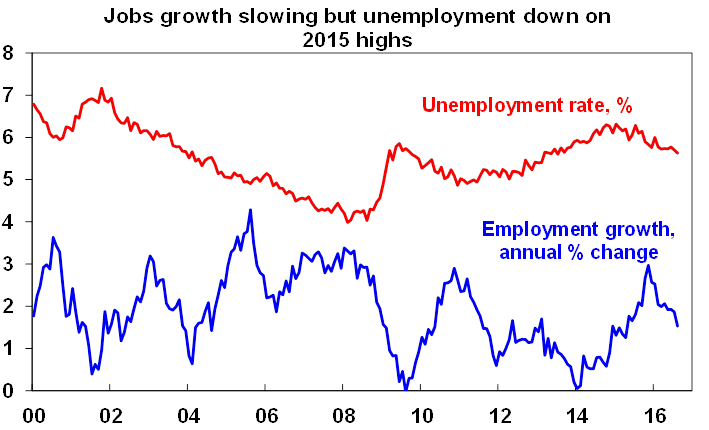Don’t look to yesterday’s August jobs figures as anything that will see the Reserve Bank cut interest rates again. Barring a slump globally (unlikely at the moment) rates will now remain on hold well into 2017. The current 1.50% level looks like being the all time low for the cash rate.
The jobs data was messy, a bit confusing, but there were enough positives to confirm the economy and jobs creation is still ticking over. But with the national accounts showing solid growth, good news from the Chinese economy, and investors realising the market weakness is temporary, the jobs data has nothing in it that will force the central bank into changing its wait and see stance next month.
The dollar traded around 74.60 – roughly where it was after the big fall 24 hours earlier.
Seasonally adjusted, the Bureau of Statistics figures show that the economy shed 3,900 jobs last month, compared with a revised gain of 25,300 (previously 26,200) in July.
While that was well below market forecasts for a gain of 15,000, the fall disguised a rise of 11,500 in full time jobs and July’s drop was revised to 43,400 (previously a fall of 45,400).
But 15,400 part-time jobs last month, down from the addition of a revised 69,600 (previously 71,600) in July, which was affected by the boost from the census at the time.
The unemployment rate eased from 5.7% to 5.6%, the lowest unemployment rate since July 2013. But the real story is the fall of 0.2% in the participation rate to 64.7% from 64.9%. That tells us more people stopped looking for work in the month, which is a bit of a negative.

On the more favoured trend basis (designed to try and smooth out the lumpiness of seasonal adjustment) the story was a bit more positive.
The ABS said trend employment increased by 9,900 persons to 11,965,100 persons – a monthly growth rate of 0.1 per cent. Trend part-time employment growth continued, with an increase of 10,200 persons, while full-time employment decreased by 400 persons.
“The trend monthly hours worked increased by 1.7 million hours (0.1 per cent), although it remained below the high in December 2015, reflecting the shift in full-time and part-time employment,” the ABS said yesterday.
In considering the contribution of the Census to employment, the ABS confirmed that it will have resulted in an increase in hours that were worked during the month, more than the persons in employment. “Of the majority of the persons who were employed for the Census, most already had another job, but worked more hours during the month,” it said.
"The trend unemployment rate remained steady at 5.7 per cent. The participation rate was also unchanged at 64.8 per cent. Both of these figures have been relatively steady since May 2016.
The AMP’s Chief Economist, Dr Shane Oliver wrote in a note yesterday after that “as is often the case, the monthly jobs numbers are messy – either bouncing around randomly from month to month or having contradictory components – and the August data is no exception.”
“But the basic message is that the labour market is still solid – employment growth at 1.5% year on year remains robust and the continuing downtrend in the unemployment rate from last year’s high of 6.3% is a positive sign.
"However, its not quite as strong as it looks because full time jobs growth is weak and the fall in the unemployment rate has been exaggerated by weaker participation (although this may be partly due to the aging population).
“The continuing softness in full time jobs and record low nominal wages growth may partly explain why to many Australians the economy doesn’t feel as strong as the good GDP growth data suggests.
"Looking ahead, forward looking indicators of jobs growth including the ANZ job vacancy survey and employment intentions in the NAB business survey point to solid employment growth. Very low wages growth are likely helping on this front,“ Dr Oliver wrote.













